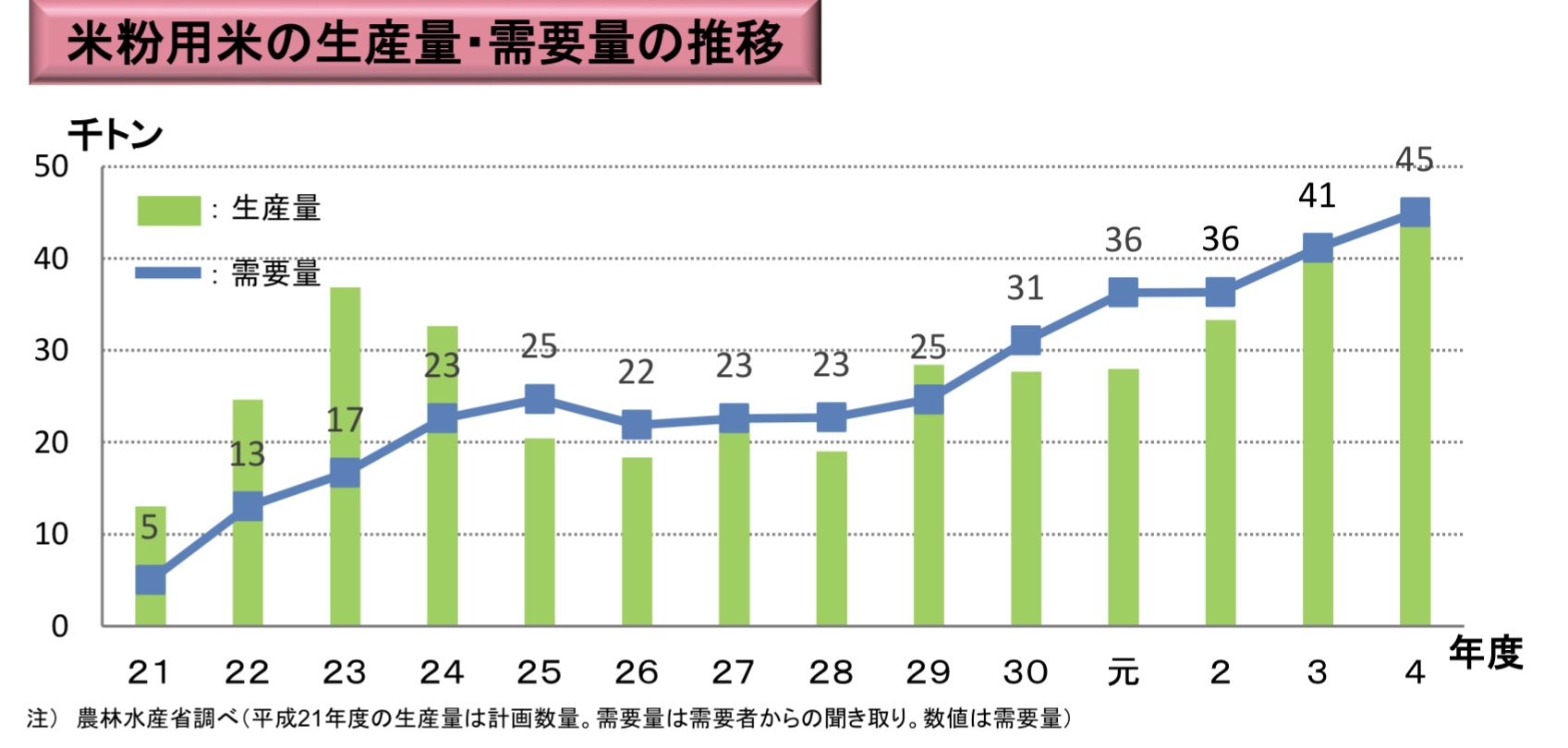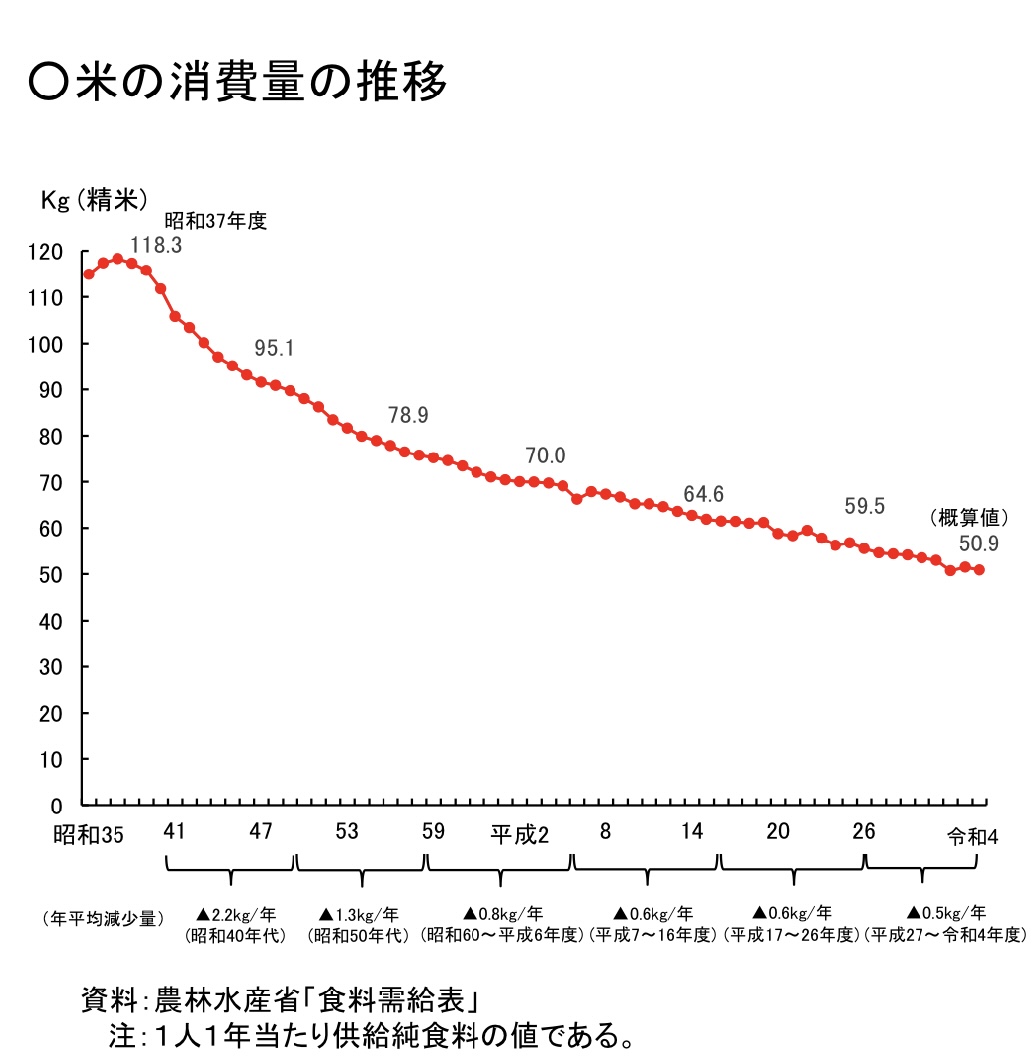
How to find the self-sufficiency rate: Calorie-based total food self-sufficiency rate = Domestic heat supply per person per day/Heat supply per person per day x 100
In 2022, the demand for rice for rice flour was 45,000 tons, and the production volume was 42,000 tons, indicating an increase in the domestic self-sufficiency rate.
However, when viewed as rice, rice consumption continues to decline as diets become more Westernized.


Suddenly, have you heard that eating rice flour increases self-sufficiency?
Because... Japan is a country with a favorable environment for rice production, and is the 8th largest rice producer in the world. Because we, who live in such a Japan, can increase our food self-sufficiency rate by using rice flour instead of wheat flour, which we rely on imports.
So why do we need to increase self-sufficiency in the first place?
Among food, clothing, and shelter, clothing and shelter can be used for a long period of time if you have them, but only food needs to be constantly renewed.
Food is such a speciality, but today Japan's food self-sufficiency rate is 38% and 62% of food (calories) is imported from overseas!
Food production uses the natural environment, such as farmland, water, and sunlight. In other words, if that environment becomes unstable due to natural disasters or abnormal weather, food production will also become unstable.
How will this affect Japan, which relies on imports for much of its food? If production in exporting countries declines, not only will commodity prices become higher, but Japan may not be able to import the commodity, prioritizing domestic supply.
In addition to drought and abnormal weather, such import risks could include natural disasters, outbreaks of livestock diseases, political instability in the exporting country, epidemics of infectious diseases, and many other things.
On a global basis, as a country develops economically, it moves from a grain-based diet to meat. In order to produce meat, feed for livestock is necessary, and more grain is needed than if the livestock ate grain as it is.
Therefore, global demand for grains is expected to increase as developing countries' economies grow.
This is very important in terms of removing the element of instability and ensuring the survival of nations.
In order to compare rice flour and wheat flour, we first need to know a lot about wheat! So...
Top 5 rice and wheat producing countries and Japan's production(2019)
| rice | wheat | |||
|---|---|---|---|---|
| ranking | name of country | production output | name of country | production output |
| 1 | China | 13,360 | China | 20,961 |
| 2 | India | 10,360 | India | 11,152 |
| 3 | Russia | 7,445 | Indonesia | 4,518 |
| 4 | The U.S. | 5,226 | Bangladesh | 2,678 |
| 5 | France | 4,060 | Vietnam | 1,923 |
| Japan | 104 | Japan | 1,053 |
| raw material prices | Milling costs | Product Price | |
|---|---|---|---|
| rice flour | About 50 yen | About 80~290 yen | About 140~340 yen |
| wheat flour | About 70~80 yen | About 60 yen | About 130~140 yen |
The cost of raw materials is lower for rice flour, but the fixed price is higher due to significantly higher milling costs.
Wheat is more pervasive So wheat flour is an essential part of the Japanese diet, but about 90% of wheat flour consumption in Japan is met by imports from the United States, Canada, Australia, and other foreign countries.
The hot and humid environment in Japan is not conducive to wheat, making it difficult to produce flour in Japan, In addition, wheat does not tolerate continuous cropping, which requires large tracts of farmland for double cropping, limiting the amount of wheat that can be produced domestically.
So why hasn't rice flour become more widely used when the temperature and humidity are ideal for rice cultivation and there are so many attractive features?
・Milling Cost Issues
As mentioned earlier, rice flour has higher milling costs and a higher fixed price than wheat flour.
For this reason, the selling price of rice flour is inevitably higher than that of wheat flour at present.
This is not only a problem for consumers, but also for bakers and other manufacturers, as the milling process differs from that of wheat flour and is more costly, making it difficult to make a profit and time-consuming.
This is a reason for bakeries and other manufacturers to shy away from the use of rice flour.
・Distribution Issues
And for the above reasons, rice flour has not penetrated people's diets because there is little distribution of products using rice flour in the first place and few opportunities to come into contact with rice flour.
・Problems specific to rice flour
The glutinous texture is a favorite texture of the Japanese, but it cannot produce the fluffy texture of wheat flour, and there are fewer recipes for it than for wheat flour.
This is thought to be one of the reasons why the use of glutinous rice is still limited.
Rice flour is attractive to both the body and the country because of its high nutritional value, including amino acids and minerals, healthy and gluten-free, and the fact that eating it increases self-sufficiency, but for the reasons listed above, it has not become very popular.
1.What is rice allergy?
Not only the protein contained in rice but also the carbohydrates in rice can cause various symptoms as allergens.
Also, certain starches may be allergens.
There are approximately 400,000 people in Japan who are allergic to rice.
It often begins in early childhood, and is different from chicken eggs and cow's milk.
It is thought that resistance can be acquired by removing it over a short period of time, but since it is a staple food, it is said to be difficult to remove.
2. Main symptoms of rice allergy
The main symptoms of rice allergy are abdominal pain, diarrhea, nausea, vomiting, and stomach cramps.
The symptoms include hives (allergic hives), itching, and eczema, and in severe cases, anaphylaxis may occur.
Symptoms are most pronounced even in grains.
3.Causes and countermeasures for rice allergy
- Pesticide residues can be resolved by choosing organically or naturally grown rice that does not use any pesticides.
・Starch (some people are unable to break down the amylopectin protein, and it is recognized as an abnormal protein and causes allergic symptoms)
⇒ Choose varieties that are low in amylopectin (such as Sasanishiki) ↔ (Akitakomachi, Do not eat relatively low amylose rice such as Hitomebore, Yumepirika, Tsuyahime, and Milky Queen)
・Relationship with other foods
⇒ Rice grown naturally without fertilizers or pesticides is extremely unlikely to contain other allergens (fishmeal, soybeans, etc.) in the organic materials used in the rice fields.
・Protein
⇒ "Shunyo" Low-glutelin rice can reduce protein intake.
農林水産省, 自給率が低いとなぜよくないの? , https://www.maff.go.jp/j/zyukyu/zikyu_ritu/ohanasi01/01-02.html
農林水産省 米粉をめぐる状況について, https://www.maff.go.jp/kyusyu/seiryuu/komeko/attach/pdf/230307-3.pdf